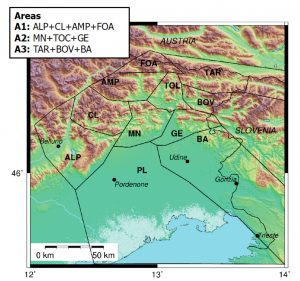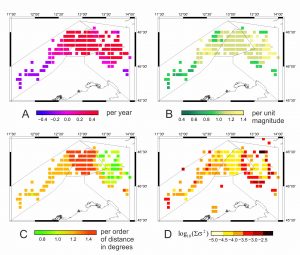New publication titled “Unified Scaling Law for Earthquakes: Space-Time Dependent Assessment in Friuli-Venezia Giulia Region” by Anastasia Nekrasova (IEPT RAS) and Antonella Peresan (National Institute of Oceanography and Experimental Geophysics (OGS), Italy) in “Frontiers in Earth Science” (JRL Q2).

The concept of the Unified Scaling Law for Earthquakes (USLE), which generalizes the Gutenberg-Richter relationship making use of the fractal distribution of earthquake sources in a seismic region, has been applied to seismicity in North-Eastern Italy. In particular, the temporal variations of USLE coefficients have been investigated, with the aim to get new insights in the evolving dynamics of seismicity within different tectonic domains of Friuli-Venezia Giulia region (FVG) and its surroundings. The research based on the catalog compiled at the National Institute of Oceanography and Applied Geophysics (OGS), considering earthquakes occurred in the period 1995–2019, with epicentres within three sub-regions of the territory under investigation, delimited based on main geological and tectonic features (Bressan et al., 2018, J. Seismol., 22, 1563–1578). To quantify the observed variability of seismic dynamics, a multi-parametric analysis has been carried out for each sub-region by means of several moving averages, including: the inter-event time, τ; the cumulative Benioff strain release, Ʃ; the USLE control parameter, η and the USLE coefficients, estimated for moving six-year time intervals.
The analysis evidenced that the USLE coefficients in FVG are time-dependent and show up correlated behaviours. Moreover, the dynamical features of the parameters in the three sub-regions highlighted a number of different seismic regimes; in particular, major changes in the parameters are associated to occurrence of the 12 April 1998 (M5.6) and the 12 July 2004 (M5.1) Kobarid (Slovenia) earthquakes within the corresponding sub-region. The results obtained for seismicity in North-Eastern Italy and surrounding areas confirm similar analysis performed on a global scale, in advance and after the largest earthquakes worldwide. In addition, the analysis evidenced the spatially heterogeneous and non-stationary features of seismicity, in agreement with results from independent analysis of background seismicity within the investigated territory (Benali et al., 2020, Stoch. Environ., Res. Risk. Assess., 34, 775–791), thus suggesting the opportunity of resorting to time-dependent models of earthquakes occurrence for improving local seismic hazard assessment.


From: Nekrasova A., Peresan A. Unified Scaling Law for Earthquakes: space-time dependent assessment in Friuli-Venezia Giulia region // Frontiers in Earth Science. 2021. V. 8. Article 590724. DOI:10.3389/feart.2020.590724

